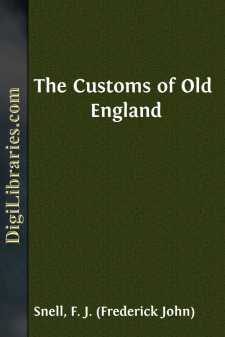Categories
- Antiques & Collectibles 13
- Architecture 36
- Art 48
- Bibles 22
- Biography & Autobiography 813
- Body, Mind & Spirit 142
- Business & Economics 28
- Children's Books 15
- Children's Fiction 12
- Computers 4
- Cooking 94
- Crafts & Hobbies 4
- Drama 346
- Education 46
- Family & Relationships 57
- Fiction 11828
- Games 19
- Gardening 17
- Health & Fitness 34
- History 1377
- House & Home 1
- Humor 147
- Juvenile Fiction 1873
- Juvenile Nonfiction 202
- Language Arts & Disciplines 88
- Law 16
- Literary Collections 686
- Literary Criticism 179
- Mathematics 13
- Medical 41
- Music 40
- Nature 179
- Non-Classifiable 1768
- Performing Arts 7
- Periodicals 1453
- Philosophy 64
- Photography 2
- Poetry 896
- Political Science 203
- Psychology 42
- Reference 154
- Religion 513
- Science 126
- Self-Help 84
- Social Science 81
- Sports & Recreation 34
- Study Aids 3
- Technology & Engineering 59
- Transportation 23
- Travel 463
- True Crime 29
The Customs of Old England
Description:
Excerpt
PREFACE
The aim of the present volume is to deal with Old English Customs, not so much in their picturesque aspect—though that element is not wholly wanting—as in their fundamental relations to the organized life of the Middle Ages. Partly for that reason and partly because the work is comparatively small, it embraces only such usages as are of national (and, in some cases, international) significance. The writer is much too modest to put it forth as a scientific exposition of the basic principles of mediæval civilization. He is well aware that a book designed on this unassuming scale must be more or less eclectic. He is conscious of manifold gaps—valde deflenda. And yet, despite omissions, it is hoped that the reader may rise from its perusal with somewhat clearer conceptions of the world as it appeared to the average educated Englishman of the Middle Ages. This suggests the remark that the reader specially in view is the average educated Englishman of the twentieth century, who has not perhaps forgotten his Latin, for Latin has a way of sticking, while Greek, unless cherished, drops away from a man.
The materials of which the work is composed have been culled from a great variety of sources, and the writer almost despairs of making adequate acknowledgments. For years past admirable articles cognate to the study of mediæval relationships have been published from time to time in learned periodicals like "Archæologia," the "Archæological Journal," the "Antiquary," etc., where, being sandwiched between others of another character, they have been lost to all but antiquarian experts of omnivorous appetite. Assuredly, the average educated Englishman will not go in quest of them, but it may be thought he will esteem the opportunity, here offered, of gaining enlightenment, if not in the full and perfect sense which might have been possible, had life been less brief and art not quite so long. The same observation applies to books, with this difference that, whereas in articles information is usually compacted, in some books at least it has to be picked out from amidst a mass of irrelevant particulars without any help from indices. If the writer has at all succeeded in performing his office—which is to do for the reader what, under other circumstances, he might have done for himself—many weary hours will not have been spent in vain, and the weariest are probably those devoted to the construction of an index, with which this book, whatever its merits or defects, does not go unprovided.
Mere general statements, however, will not suffice; there is the personal side to be thought of. The great "Chronicles and Memorials" series has been served by many competent editors, but by none more competent than Messrs. Riley, Horwood, and Anstey, to whose introductions and texts the writer is deeply indebted. Reeves' "History of English Law" is not yet out of date; and Mr. E. F. Henderson's "Select Documents of the Middle Ages" and the late Mr. Serjeant Pulling's "Order of the Coif," though widely differing in scope, are both extremely useful publications....


